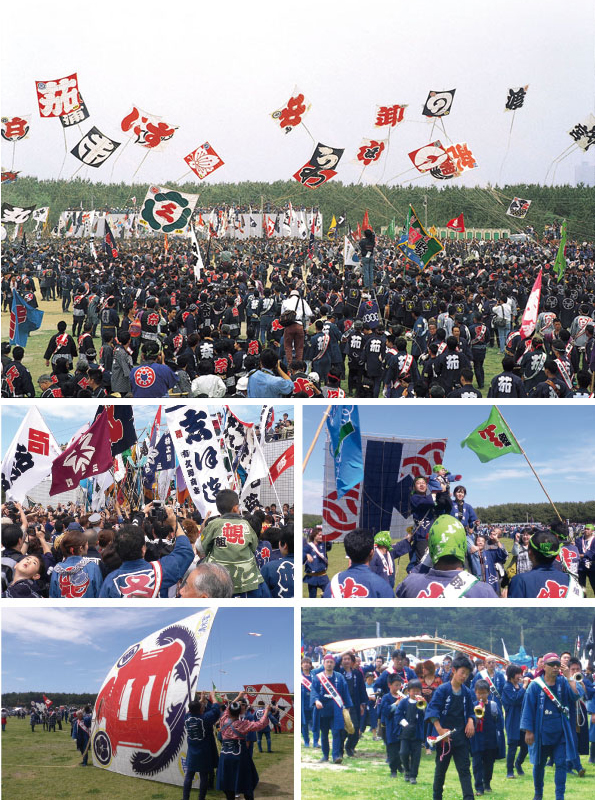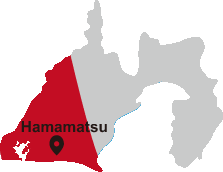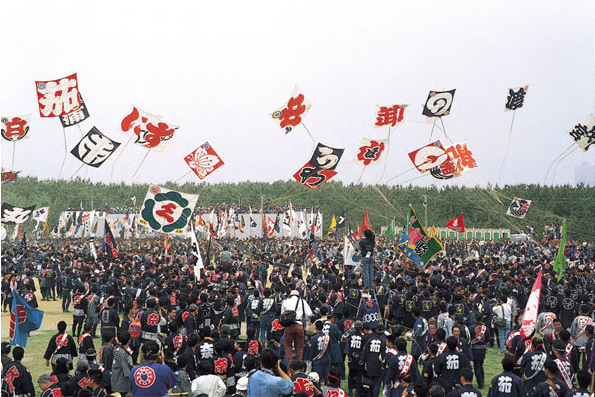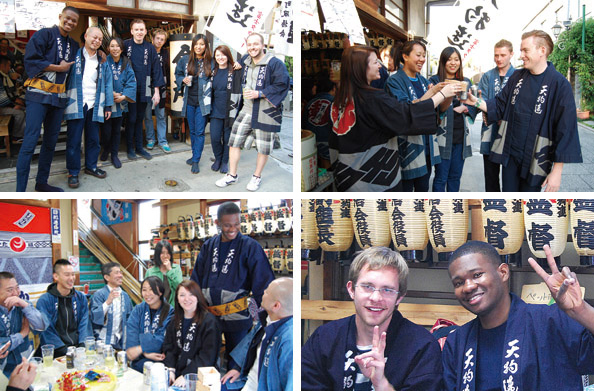
May 3 - 5
The giant kites battles on Nakatajima beach
3rd and 4th 10am-3pm/
5th 12pm〜3pm
The pulling of the Goten Yatai in the downtown central of Hamamatsu
(North side of Hamamatsu Station)
(North side of Hamamatsu Station)
3rd and 4th 6:30pm〜9pm
The Hamamatsu festival held May 3-5 is independent of shinto and buddhist temple observations. It is a festival to celebrate the birth of a child. Various events are held at two main venues each with their main attraction "a kite-flying battle" at Nakatajima beach and "a parade of palace floats" downtown. It is Hamamatsu 's most bustling time of year as the city population swells to 1.5 million people.
Birth, "the first kite" is flown high in the sky for healthy growth of the child
The history of kite-flying in Hamamatsu dates back to the Eiroku era year (1558-1569) more than 450 years ago. According to "Hamamatsu Castle history" written in the Edo era, a large kite was flown for Yoshihiro the oldest son of the Prince of Hikuma castle (Hamamatsu Castle) of 飯尾豊前守 (いいおぶぜんのかみ) boasting the most important and oldest kite-flying history. Thereafter firstborn son's births have been celebrated in the Hamamatsu district as "Boy's Festival", and a custom to fly "the first kite" on which family coat of arms and the name s of the baby (Hatsuko) are hand drawn and written with ink in hope of future growth. (not only the eldest son, even the second son and a girl partake in kite-flying to celebrate birth now.)
The event grounds are suitable climatically due to the wind "the strong, dry wind of Enshu" often blowing allowing the large kites a successful lift off to long and high flights then repeated annually as children (Hatsuko) grow up.
The kite-flier battle is fought in the kite-flier meeting place of middle Tajima dune facing the rough Enshu sea. Large kites of 170 towns are flown after the fireworks signal high in the sky all at once as the kite-flier battle commences with several hundred people jumbling together in a swirling melee. Kite strings which coil themselves and others are called "quarrel kites" their threads cut by friction. The friction creates a cloud of smoke and dust which rises up wrapping all into the heat and excitement of the moment.
The event grounds are suitable climatically due to the wind "the strong, dry wind of Enshu" often blowing allowing the large kites a successful lift off to long and high flights then repeated annually as children (Hatsuko) grow up.
The kite-flier battle is fought in the kite-flier meeting place of middle Tajima dune facing the rough Enshu sea. Large kites of 170 towns are flown after the fireworks signal high in the sky all at once as the kite-flier battle commences with several hundred people jumbling together in a swirling melee. Kite strings which coil themselves and others are called "quarrel kites" their threads cut by friction. The friction creates a cloud of smoke and dust which rises up wrapping all into the heat and excitement of the moment.

Parading fantastic palace floats of all colors at night in town
The palace float (ごてんやたい) "a stand" points to a festival car of an Enshu district which is decorated with a luxurious sculpture or curtain. As for the opening of the palace stand of the Hamamatsu festival, geisha and a large number of people of Temmacho and Chitosecho parade around as stands grow to bells and a drums, attendees of the floats are the returning kite-fliers since the Meiji era. In the Taisho era, floats which displayed artificial flowers and a lanterns were used. From the early days of the Showa era, each town has made grand floats competitively, and floats included many carvings as roofs became more and more elaborate, with floats of today being gorgeous. The excitement of the daytime kite-fighting dissipates at dusk as it cools down, and the stage of the Hamamatsu festival moves to the center of commerce of Hamamatsu-shi. The wonderful sculpture and decoration made of intricate plans from each and every town are signaled by the sound of the samisen which a player plucks, a flute and the musical accompaniment of neatly dressed children, who play on the lit floats which move slowly wrapped up in pageantry of elegance attracting people with their beauty like a royal festival picture scroll. There are 104 palace stands participating in Hamamatsu festival, and 83 of those parade around the center of commerce.


A lot of non-Japanese living in Hamamatsu also participate in the Hamamatsu Festival. While learning about traditional practices, they participate from the preparation stage and enjoy the festival as a member of the town.
2024. 4. 21 update
Content may be subject to change after publication. Please also note that we are not accountable for loses and damages that may occur as a result of said changes.
Content may be subject to change after publication. Please also note that we are not accountable for loses and damages that may occur as a result of said changes.







